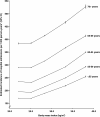Hospital admissions in relation to body mass index in UK women: a prospective cohort study
- PMID: 24629170
- PMCID: PMC4003825
- DOI: 10.1186/1741-7015-12-45
Hospital admissions in relation to body mass index in UK women: a prospective cohort study
Abstract
Background: Adiposity is associated with many adverse health outcomes but little direct evidence exists about its impact on the use of health care services. We aim to describe the relationship between body mass index (BMI) and rates of hospital admission in middle-aged UK women.
Methods: Among 1,251,619 Million Women Study participants, 50- to 64-years old at entry into the study, routine data on hospital admissions were used to estimate hospitalization rates according to BMI after standardization for age, region of recruitment, socioeconomic status, reproductive history, smoking status, hormonal therapy use and alcohol intake. Proportional hazards models were used to estimate adjusted relative risks of hospitalization separately for 25 common types of admission.
Results: During an average of 9.2 years follow-up, there were 2,834,016 incident hospital admissions. In women with BMIs (in kg/m2) of <22.5, 22.5 to <25, 25 to <30, 30 to <35 and 35+ standardized admission rates (and 95% confidence intervals (CIs)) per woman over a 10-year period were 2.4 (2.4 to 2.4), 2.4 (2.3 to 2.4), 2.6 (2.6 to 2.6), 3.0 (3.0 to 3.0) and 3.5 (3.4 to 3.5), respectively (P-value for heterogeneity <0.001). The relative increase in admission rates per 5 kg/m2 increase in BMI was 1.12 (1.12 to 1.13). This relationship did not vary materially by age. Corresponding average durations of stay (in days) per hospital visit within the same categories of BMI were: 3.1 (3.1 to 3.2), 2.8 (2.7 to 2.8), 2.9 (2.9 to 2.9), 3.2 (3.1 to 3.2) and 3.8 (3.7 to 3.8), respectively (P <0.001).Significant increases in the risk of admission with increasing BMI were observed for 19 of the 25 types of hospital admission considered. BMI was most strongly associated with admissions with diabetes, knee-replacement, gallbladder disease and venous thromboembolism, but marked associations were found with many other common categories of admission including cataracts, carpal tunnel syndrome and diverticulitis.
Conclusions: Among women 50- to 84-years old in England, around one in eight hospital admissions are likely to be attributable to overweight or obesity, translating to around 420,000 extra hospital admissions and two million extra days spent in hospital, annually.
Figures



Comment in
-
The impact of excess body weight at the hospital frontline.BMC Med. 2014 Apr 17;12:64. doi: 10.1186/1741-7015-12-64. BMC Med. 2014. PMID: 24742301 Free PMC article.
References
-
- Health Survey for England, 2010. 1. Colchester, Essex: UK Data Archive. SN: 6986; 2012. National Centre Social Research and Royal Free and University College Medical School Department of Epidemiology and Public Health.
Publication types
MeSH terms
Grants and funding
LinkOut - more resources
Full Text Sources
Other Literature Sources
Molecular Biology Databases

